
A goddess is a female deity. In many known cultures, goddesses are often linked with literal or metaphorical pregnancy or imagined feminine roles associated with how women and girls are perceived or expected to behave. This includes themes of spinning, weaving, beauty, love, sexuality, motherhood, domesticity, creativity, and fertility. Many major goddesses are also associated with magic, war, strategy, hunting, farming, wisdom, fate, earth, sky, power, laws, justice, and more. Some themes, such as discord or disease, which are considered negative within their cultural contexts also are found associated with some goddesses. There are as many differently described and understood goddesses as there are male, shapeshifting, or neuter gods.

ParvatiUma or Gauri is the Hindu goddess of power, energy, nourishment, harmony, love, beauty, devotion, and motherhood. In her complete form, she is a physical representation of Mahadevi also known as Adi Shakti, the primordial power behind the creation of the universe, the creator and destroyer. She is one of the central deities of the goddess-oriented sect called Shaktism, and the supreme goddess in Shaivism. Along with Lakshmi and Sarasvati, she forms the Tridevi.

Lakshmi also known as Shri, is one of the principal goddesses in Hinduism. She is the goddess of wealth, fortune, power, beauty, fertility and prosperity, and associated with Maya ("Illusion"). Along with Parvati and Saraswati, she forms the Tridevi of Hindu goddesses.

Durga is a major Hindu goddess, worshipped as a principal aspect of the mother goddess Mahadevi. She is associated with protection, strength, motherhood, destruction, and wars.
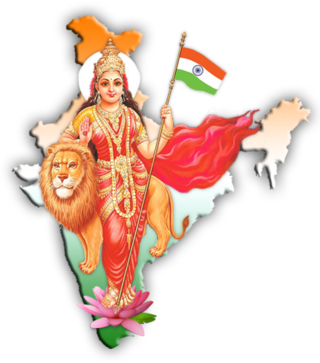
Bharat Mata is a national personification of India (Bharat) as a mother goddess. Bharat Mata is commonly depicted dressed in a red or saffron-coloured sari and holding a national flag; she sometimes stands on a lotus and is accompanied by a lion.
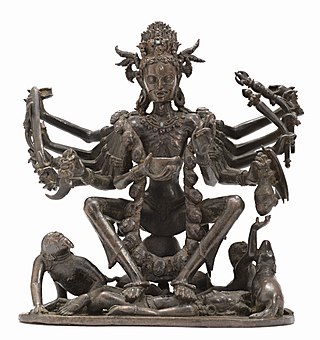
Chamunda, also known as Chamundeshwari, Chamundi or Charchika, is a fearsome form of Chandi, the Hindu mother goddess, aka Shakti and is one of the seven Matrikas.

Shaktism is one of the several major Hindu denominations wherein the metaphysical reality, or the godhead, is considered metaphorically to be a woman.
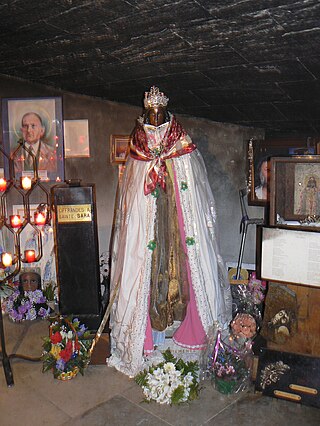
Saint Sarah, also known as Sara-la-Kâli, is the patron saint of the Romani people. The center of her veneration is Saintes-Maries-de-la-Mer, a place of pilgrimage for Roma in the Camargue, in Southern France. Legend identifies her as the servant of one of the Three Marys, with whom she is supposed to have arrived in the Camargue. Saint Sarah also shares her name with the Hindu goddess Kali who is a popular goddess in northern India from where the Romani people originate. The name "Sara" itself is seen in the appellation of Durga as Kali in the famed text Durgasaptashati.
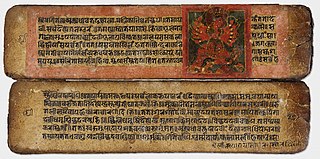
The Devi Mahatmya or Devi Mahatmyam is a Hindu philosophical text describing the Goddess, known as Mahadevi or Adishakti, as the supreme power and creator of the universe. It is part of the Markandeya Purana.

Sati, also known as Dakshayani, is the Hindu goddess of marital felicity and longevity, and is worshipped as an aspect of the mother goddess Shakti. Sati was the first wife of Shiva, the other being Parvati, who was Sati's reincarnation after her death.

A gramadevata is the tutelary deity of a given locality in Hinduism, primarily worshipped in the villages of India.

Santoshi Mata or Santoshi Maa is a Hindu goddess, who is venerated as "the Mother of Satisfaction", the meaning of her name. Santoshi Mata is particularly worshipped by women of North India and Nepal. A vrata called the Santoshi Maa vrata performed by women on 16 consecutive Fridays wins the goddess' favour.

Sheetalalit. '"coolness"', also spelled as Shitala and Seetla, is a Hindu goddess venerated primarily in North India. She is regarded to be an incarnation of the goddess Parvati. She is believed to cure poxes, sores, ghouls, pustules, and diseases, and most directly linked with the disease smallpox. Sheetala is worshipped on Tuesday Saptami and Ashtami, especially after Holi during the month of Chaitra. The celebration of the goddess Sheetala on the seventh and eighth day of the Hindu month is referred to as the Sheetala Saptami and Sheetala Asthami, respectively.
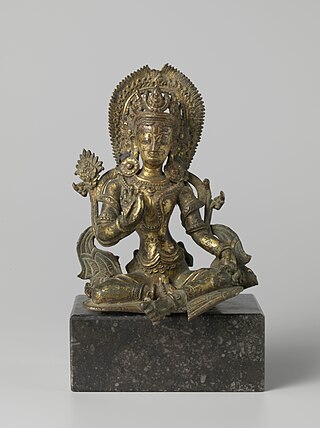
Indrani, also known as Shachi, is the queen of the devas in Hinduism. Described as tantalisingly beautiful, proud and kind, she is the daughter of the asura Puloman and the consort of the king of the devas, Indra.
The roots of Shaktism – a Hindu denomination that focuses worship upon Shakti or Devi, the Hindu Divine Mother – penetrate deeply into India's prehistory. The Devi's earliest known appearance in Indian Paleolithic settlements is believed to go back more than 8000 years ago.

Kali or Kalika is a major Hindu goddess associated with time, doomsday, and death in Shaktism. Kali is the first of the ten Mahavidyas in the Hindu tantric tradition.

Devī is the Sanskrit word for 'goddess'; the masculine form is deva. Devi and deva mean 'heavenly, divine, anything of excellence', and are also gender-specific terms for a deity in Hinduism.
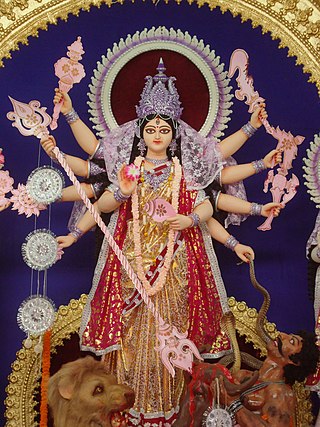
Shakti is the fundamental cosmic energy and a central deity within Shaktism, a significant theological tradition of Hinduism. Representing dynamic forces that permeate the universe, Shakti embodies feminine energy and is often depicted as the consort of Shiva. In this tradition, Devi, the Goddess, is regarded as the Supreme Brahman herself, with all other divine forms seen as her manifestations. The worship of Shakti entails a diverse array of goddesses, including Durga, Kali, Parvati, and Tripura Sundari, each representing unique facets of her power.
Badi Mata/Chamariya Mata is a Hindu goddess of disease, one of a group of seven sister goddesses with similar associations. Chamariya Mata/Badi Mata is doubtless allied to Chamars. Badi Mata is worshipped by some tribes in India, such as the Saharia, Chamar and the Kamar. Her worshippers believe that her wrath causes people to suffer from smallpox. The worshippers sacrifice goats to appease her.

Seetla Mata is a folk deity forming part of Punjabi folk religion. Seetla is the goddess of smallpox and is worshiped for its recovery. She also manifests herself in the form of chicken pox and is venerated for recovery.

















